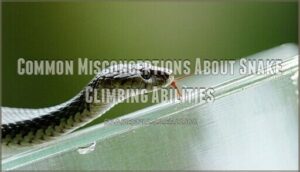This site is supported by our readers. We may earn a commission, at no cost to you, if you purchase through links.

The secret lies in their ability to create thousands of tiny contact points simultaneously through serpentine motion and strategic body positioning. Environmental factors like humidity also play a role—wet snakes can even use surface tension to their advantage.
However, perfectly smooth, clean glass remains their greatest challenge, which explains why certain glass treatments work so effectively as barriers.
Table Of Contents
- Key Takeaways
- Can Snakes Climb Glass?
- What Other Surfaces Can Snakes Climb?
- Factors Determining Snakes’ Climbing Preferences
- How to Prevent Snakes From Climbing Glass?
- Common Misconceptions About Snake Climbing Abilities
- Tips for Snake-Proofing Your Property
- Professional Solutions for Snake Control
- Frequently Asked Questions (FAQs)
- How do snakes grip onto smooth glass surfaces?
- Are there any specific snake species that are better climbers than others?
- Can snakes climb walls made of materials other than glass?
- What are some effective methods for preventing snakes from climbing glass?
- Are there any common misconceptions about snake climbing abilities?
- Do baby snakes climb glass differently than adults?
- Which snake body shapes climb glass most efficiently?
- Do snakes get tired faster when climbing glass?
- Conclusion
Key Takeaways
- You’ll be surprised to learn snakes can climb glass using microscopic friction – their ventral scales grip tiny surface imperfections and scratches that you can’t see with the naked eye.
- Smaller, younger snakes actually perform better at glass climbing than larger ones – they’re lighter and can distribute their weight more effectively across multiple contact points.
- Environmental factors like humidity work in their favor – wet snakes can use surface tension to their advantage, making climbing easier under certain conditions.
- You can prevent glass climbing by keeping surfaces ultra-smooth and clean – applying clear protective films or specialized coatings eliminates the microscopic texture snakes need for grip.
Can Snakes Climb Glass?
You’ve probably watched a nature documentary and wondered if snakes can actually scale that smooth glass terrarium wall.
The surprising truth is that most snakes can climb glass surfaces, though their success depends on factors like the glass texture, snake species, and climbing technique used.
Factors Affecting Snake Climbing Abilities
Understanding snake-scale friction becomes vital when you’re wondering about these extraordinary reptiles’ climbing abilities. Several biomechanical adaptations determine whether snakes can conquer glass surfaces, and it’s not as straightforward as you might think.
Glass texture impact plays the biggest role in climbing success. When snakes encounter smooth glass, their ventral scales struggle to create the necessary friction coefficient for upward movement. However, reptilian locomotion involves complex muscular control that responds to surface roughness effects.
Here are five key factors affecting snake climbing abilities:
- Scale orientation – Ventral scales must angle correctly against the surface
- Body length – Longer snakes distribute weight better across contact points
- Surface texture – Even microscopic roughness dramatically improves traction
- Species-specific adaptations – Some snakes possess specialized climbing technique variations
- Environmental conditions – Temperature affects muscle flexibility and grip strength
These biomechanics explain why your pet snake might struggle with terrarium walls while easily scaling tree bark. The physics of friction ultimately determines climbing success.
Techniques Used by Snakes to Climb Glass
Against all odds, snakes can scale glass using specialized biomechanics. Here’s how these climbing techniques work:
- Ventral Scale Digging: Belly scales grip microscopic imperfections, creating friction points for upward movement.
- Serpentine Motion: S-shaped curves distribute pressure across multiple contact points, maximizing grip strength.
- Transverse Pushing: Sideways pressure against glass edges enhances friction coefficients through strategic body positioning.
- Microscopic Friction: Snake climbing abilities rely on ventral scale texture creating thousands of tiny grip points simultaneously.
These snake climbing techniques demonstrate nature’s impressive adaptability. The study of snake climbing reveals the importance of glass climbing techniques in understanding their unique abilities.
What Other Surfaces Can Snakes Climb?
You might be surprised to learn that snakes can climb many surfaces beyond glass, including rough wood, brick walls, stone surfaces, and even some metal textures.
While smooth surfaces like polished concrete and steel present challenges similar to glass, snakes excel at scaling textured materials where their ventral scales can create friction and grip.
Snakes’ Ability to Climb Vertical Surfaces
Beyond glass surfaces, you’ll find snakes possess impressive snake climbing abilities on countless vertical structures. These reptiles demonstrate impressive vertical ascension through complex snake adaptations and biomechanics.
When snakes climb glass or attempt vertical surface climbing, they’re showcasing evolutionary mastery that extends to brick walls, rough wood, and textured concrete. Their climbing techniques involve specialized ventral scales that create friction against surfaces.
Snake adaptations include muscular control systems that allow them to navigate challenging terrain with surprising efficiency. While smooth surfaces pose difficulties, snakes excel at conquering rugged vertical surfaces through pressure application and strategic body positioning that maximizes grip potential.
Snakes’ Climbing Techniques on Different Surfaces
Mastery over different surfaces reveals how snakes adapt their climbing strategies based on friction mechanics and surface textures. You’ll find that snakes employ distinct techniques for each material they encounter. On rough surfaces like brick or tree bark, they use ventral scale digging to anchor themselves securely. When attempting to climb glass or smooth surfaces, snakes rely on biomechanical advantages through specialized scale adaptations. Their ability to climb vertical surfaces depends heavily on available grip points and surface roughness. Textured walls allow standard serpentine movement, while glass climbing requires modified concertina techniques where snakes compress and extend their bodies strategically.
- Watch a snake’s belly scales grip like tiny hooks on rough surfaces
- Feel amazed by their ability to defy gravity on near-vertical walls
- Discover how they turn smooth challenges into climbing opportunities
- Appreciate nature’s engineering in every calculated movement
Factors Determining Snakes’ Climbing Preferences
You’ll find that not all snakes approach climbing the same way, and several key factors determine whether they’ll attempt to scale that glass door or window.
The snake’s species, body length, environmental conditions like temperature and humidity, plus the specific texture and cleanliness of the glass surface all play vital roles in their climbing decisions.
Snake Species and Climbing Abilities
Different snake species show notable variations in their climbing abilities. Arboreal species like green tree pythons and rough green snakes excel at vertical movement, using specialized snake scales and prehensile tails for grip. Meanwhile, terrestrial species struggle more with smooth surfaces. Some, like the paradise flying snake, can even glide between trees.
Here’s how species variations affect climbing techniques:
| Species Type | Climbing Techniques | Scale Friction |
|---|---|---|
| Arboreal (Tree pythons) | Concertina locomotion, tail anchoring | High-friction ventral scales |
| Semi-arboreal (Rat snakes) | Body pressure modulation, belly scale engagement | Moderate friction adaptation |
| Terrestrial (Garter snakes) | Opportunistic climbing, limited vertical ability | Basic scale structure |
Snake adaptations reflect millions of years of biomechanics evolution, with climbing abilities directly tied to species characteristics and habitat needs.
Environmental Factors Influencing Snake Climbing
Environmental conditions create a complex web of factors that influence your snake encounters around glass surfaces. Surface texture remains the primary challenge, as perfectly smooth glass offers minimal friction for most snake adaptations to work effectively. However, temperature plays a surprisingly vital role—warmer glass surfaces actually provide slightly better grip than cold ones, as they increase flexibility in snake scales.
Humidity levels directly affect snake behavior patterns, with higher moisture creating temporary micro-condensation that can either help or hinder climbing techniques depending on the species. You’ll notice increased snake activity during specific environmental conditions, particularly dawn and dusk when temperatures stabilize.
Stress factors like nearby predators or food sources can override a snake’s natural caution around challenging surfaces. Understanding these environmental triggers helps you predict when snakes might attempt glass climbing in your area. Environmental enrichment in natural habitats often reduces the likelihood of snakes exploring artificial surfaces like windows.
- **Friction Analysis reveals that even microscopic surface irregularities can dramatically improve climbing success rates.
How to Prevent Snakes From Climbing Glass?
If you’re worried about snakes scaling your glass windows or doors, you can take practical steps to make these surfaces completely unclimbable. Applying clear protective films or specialized coatings creates an ultra-smooth barrier that eliminates the microscopic texture snakes need for grip, while keeping glass surfaces spotlessly clean removes any debris that might provide traction.
Applying Clear Coatings or Films to Glass Surfaces
When you’re looking to stop snakes from scaling your glass surfaces, clear coating applications offer a practical solution. Glass surface modification through specialized films creates an effective slippery barrier creation system that makes snake climbing nearly impossible. These anti-climb technologies work by optimizing film thickness to eliminate the microscopic texture snakes need for grip.
Clear coatings transform your glass surfaces into fortress-like barriers that even the most determined serpents can’t conquer. The beauty lies in their invisibility—you maintain your view while preventing snake climbs.
Professional-grade films provide long-lasting protection, though DIY options exist for budget-conscious homeowners. Think of it as giving your windows a superpower against unwanted reptilian visitors.
Ensuring Smooth and Slippery Surfaces
Beyond applying protective coatings, you’ll need to maintain consistently smooth surfaces to prevent snakes from gaining any foothold on your glass. Think of it like creating an ice rink for reptiles – the smoother the surface, the less chance they have to climb glass successfully.
Here are four key friction reduction methods for effective glass surface treatment:
- Regular cleaning protocols – Remove dirt, debris, and microscopic particles that could provide texture for snake scales to grip during glass climbing attempts.
- Slippery barrier coatings application – Apply specialized non-toxic sprays or films that create ultra-smooth wall designs, making glass surface climbing nearly impossible.
- Eliminate surface imperfections – Sand down any scratches, chips, or rough patches that might offer traction points for determined climbers.
- Install snake deterrent textures – Use reverse psychology by placing ultra-slick materials like treated acrylic panels over existing smooth surfaces, creating an impenetrable barrier.
These friction reduction methods work because snakes rely entirely on their ventral scales creating microscopic contact points with surfaces to generate forward momentum.
Common Misconceptions About Snake Climbing Abilities
Many snake myths paint these reptiles as glass-climbing superheroes, but the truth is more nuanced. You’ve probably heard that snakes can climb glass surfaces effortlessly – that’s simply not accurate. While snakes can climb glass under certain conditions, it’s actually energy-intensive work.
While snakes can scale glass surfaces, it’s actually energy-intensive work that requires specific conditions, not effortless superhero abilities
Their climbing mechanics rely on friction theory and scale adaptation, not magical abilities. The biomechanics involved require specific surface textures and considerable muscle effort. Snake climbing behavior varies dramatically between species, and glass climbing challenges even the most skilled climbers.
Understanding these realities helps separate fact from fiction about snake climbing abilities.
Tips for Snake-Proofing Your Property
Now that you understand snakes can climb certain glass surfaces under specific conditions, you’ll want to protect your property from these surprisingly agile visitors. Creating an effective snake-proof barrier involves sealing entry points and removing features that attract these reptiles, which can prevent costly encounters and keep your family safe.
Securing Entry Points and Seal Cracks
Smart snake-proofing property begins with a thorough entry point security inspection. You’ll need to examine every potential access area where snakes might squeeze through. Check windows, doors, foundation cracks, and ventilation systems for gaps.
Use quality sealant materials and crack repair techniques to close these openings permanently. Weatherstripping works well for door frames, while caulk addresses smaller cracks effectively. Install barrier installation systems like door sweeps to block ground-level access.
Remember, preventing snake entry requires attention to detail—even tiny gaps can become highways for determined snakes seeking shelter or food sources.
Removing Attractive Features for Snakes
Creating a snake-free haven starts with eliminating the features that roll out the welcome mat for these slithery visitors. Your landscape design choices directly impact snake climbing opportunities and their desire to stick around. Remove wood piles, rock formations, and dense vegetation where snakes seek shelter.
Tall grass and overgrown shrubs provide perfect hiding spots, so keep lawns trimmed short. Consider fence materials like smooth vinyl instead of rough wood that aids snake climbing. Glass surfaces and wall texturing modifications can serve as effective snake deterrents.
Clear away debris, fallen branches, and leaf litter that create cozy snake hideouts. Glass coatings on windows and doors help with preventing snake entry by eliminating grip points.
Remember, snakes follow food sources, so control rodent populations and remove bird feeders that attract prey animals to your property.
Professional Solutions for Snake Control
When your DIY snake-proofing efforts aren’t cutting it, professional pest control services offer specialized expertise and sophisticated technologies that tackle persistent snake problems.
These experts use proven methods like targeted barriers, electronic deterrents, and thorough property assessments to create long-term solutions you can’t achieve with store-bought products.
Hiring Pest Control Services
Professional pest control services offer your best defense against persistent snake problems, especially when dealing with species that exhibit glass climbing behavior. These certified experts understand snake behavior patterns and employ targeted snake control methods that DIY approaches simply can’t match.
When selecting a service, consider these key factors:
- Professional certification – Verify technicians hold proper wildlife management licenses
- Customer reviews – Check ratings for snake proofing property success rates
- Service quality – Ask about thorough inspections and follow-up visits
- Emergency response – Confirm 24/7 availability for urgent snake encounters
- Pest control costs – Compare pricing for long-term prevention versus one-time removal
Licensed professionals bring specialized knowledge about local snake species and their climbing abilities, ensuring your property receives appropriate treatment for lasting protection.
Advanced Technologies for Snake Prevention
Beyond traditional pest control services, advanced technology offers powerful Snake Control Methods for Snake Proofing Property. Smart Fences equipped with sensors detect slithering movements and activate deterrent systems automatically. AI Detection cameras identify snake species and trigger appropriate responses. Thermal Imaging technology tracks heat signatures, revealing hidden snakes before they reach Glass Surfaces. Ultrasonic Repellents emit frequencies that make snakes uncomfortable without disturbing humans. Robotic Deterrents patrol perimeters, mimicking predator movements.
These innovations, inspired by Bioinspired Engineering research, transform Snake Enclosure Design and property protection, creating invisible barriers that outsmart even the cleverest climbing species.
Frequently Asked Questions (FAQs)
How do snakes grip onto smooth glass surfaces?
Unlike suction cups, you’ll discover snakes grip glass through microscopic friction and pressure differential.
Their specialized ventral scales dig into tiny surface imperfections, creating enough traction to climb surprisingly smooth surfaces.
Are there any specific snake species that are better climbers than others?
You’ll find brown tree snakes are nature’s climbing champions, mastering the lasso technique on smooth cylinders. They outperform other species through specialized ventral scales and energy-efficient movement patterns.
Can snakes climb walls made of materials other than glass?
Ironically, while glass stumps most snakes, they’re surprisingly adept at conquering textured walls.
You’ll find them scaling brick, stone, rough wood, and concrete with ease using their specialized belly scales for grip.
What are some effective methods for preventing snakes from climbing glass?
You can keep glass surfaces smooth by applying clear coatings or films.
Clean glass regularly to remove debris.
Seal entry points around windows and use smooth materials like vinyl instead of textured surfaces nearby.
Are there any common misconceptions about snake climbing abilities?
You might think snakes use suction cups or sticky secretions, but they don’t. Their climbing relies purely on friction from belly scales and biomechanical pressure techniques, not magic adhesion.
Do baby snakes climb glass differently than adults?
Young serpents face additional challenges when tackling slick surfaces. Baby snakes have proportionally smaller ventral scales, reducing their friction coefficient on glass.
Their lighter weight can’t generate enough pressure for effective grip, making vertical climbs nearly impossible compared to adults.
Which snake body shapes climb glass most efficiently?
Slender-bodied snakes with longer lengths climb glass most efficiently. Thin, elongated species can distribute their weight better and maintain more contact points against smooth surfaces than stocky snakes.
Do snakes get tired faster when climbing glass?
Yes, you’ll notice snakes exhaust themselves much quicker on glass surfaces. The smooth texture forces them to work harder, using extra muscle power to prevent slipping, making climbing glass far more energy-intensive than rougher surfaces.
Conclusion
Like medieval knights scaling castle walls, you’ve discovered that snakes can indeed conquer glass barriers through extraordinary adaptations. Can snakes climb glass? The surprising answer lies in their ability to exploit microscopic surface imperfections using specialized ventral scales.
While perfectly smooth glass remains challenging, most real-world surfaces provide enough texture for determined serpents. Understanding these climbing mechanisms helps you implement effective prevention strategies, from surface treatments to professional barriers, ensuring your property stays snake-free through science-backed solutions.
- https://phoenix.aaacwildliferemoval.com/blog/can-snakes-climb-walls/
- https://www.reddit.com/r/snakes/comments/1ggkg3k/my_family_is_convinced_these_are_snake_tracks_on/
- https://snek.blog/post/635440358368624640/hey-i-saw-a-post-about-glass-surfing-from-snakes
- https://www.uc.edu/news/articles/2021/01/biologists-discover-bizarre-lasso-snake-locomotion.html
- https://www.crittercontrol.com/wildlife/snakes/snake-in-attic/














